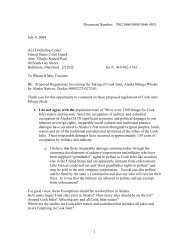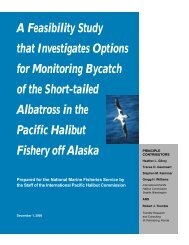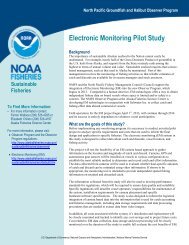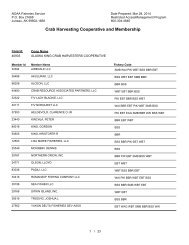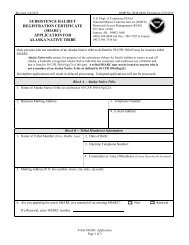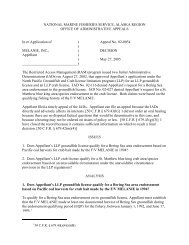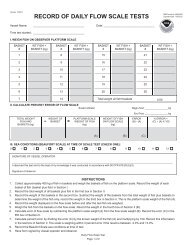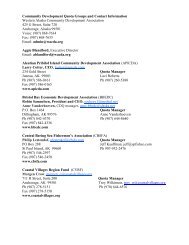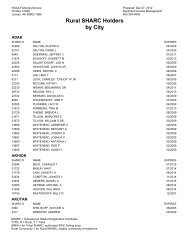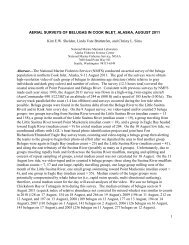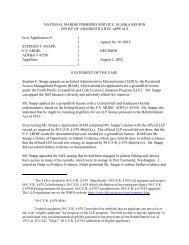Revised Report - National Marine Fisheries Service Alaska Region ...
Revised Report - National Marine Fisheries Service Alaska Region ...
Revised Report - National Marine Fisheries Service Alaska Region ...
You also want an ePaper? Increase the reach of your titles
YUMPU automatically turns print PDFs into web optimized ePapers that Google loves.
Kodiak and Homer had landings spread out through the season, and did not reach 50% of totalweight until the modal months of July or August.Targeted halibut catch and effort. IPHC log information describes over 41 millionpounds caught by over 28 million hooks (Table 7). However, 95% of the catch – about 39million pounds – was the result of about 70% of the hooks – 20 million – directed at Pacifichalibut. Also, while log data represent effort from fishing that targeted sablefish or other species,only those sets of fishing gear that caught halibut are recorded. The Bering Sea had the highestproportion of directed halibut effort – 84% of the hooks, and Areas 2C and 3A had the lowest –65%. However, these data would not be a good representation of either directed sablefish effortor mixed fishing effort.Seasonal halibut effort by number of hooks. Effort during 1998 by IPHC regulatoryarea and month for vessels and sets targeting Pacific halibut (Table 8) showed a similar pattern tothe monthly catch by area and port (Tables 5 and 6). Fluctuations in monthly effort weresomewhat greater than those in the monthly catch by port. Total peak effort occurred during Juneand September, and generally ranged from 2.3 to 3.0 million hooks per month from May throughSeptember. Most of the Area 2C effort occurred early in the season, and effort in Areas 4occurred mostly during June and July.Gear and hook type and hook size. Virtually 100% of the hooks fished during 1998were circle hooks, with only a few J-type hooks documented. Over 75% of these hooks werefished with fixed gear, which includes both skate-bottom and tub gear (Table 9). A further 16%were fished with snap gear, and 8% were fished with autoline gear. Troll, commercial handline,mixed fixed and snap gear, and unknown gear types combined accounted for less than onepercent of the fishing documented in the logs. There is a wide variation of gear fished by vesselscatching Pacific halibut. For vessels and sets directly targeting Pacific halibut, there are aboutequal amounts of short spacing and long spacing, short gear using more of the smaller 14/0hooks, while the longer-spaced gear uses almost all the larger 16/0 hook. The small hooks/shortspacing gear that was used during sets targeting halibut could be from sablefish trips where a fewdirected halibut sets were fished. The smaller hooks and shorter spacing are most common in theefforts targeting sablefish, or both halibut and sablefish.Log data by vessel size. Comparing the logbook data to total commercial landing data byvessel length (Table 10), the logbook data represent over 75% of the weight of halibut landed byvessels over 40 feet in length. The vessels over 40 feet in length landed 82% of the total catch in1998, and landed about 87% of the weight accounted for by logbook data. The logbook datarepresent 58% to 67% of the weight landed by vessels between 31 and 40 feet. For vessels under30 feet in length the logbook data represent 24% of the catch. However, vessels under 30 feetaccount for only 3% of the total landings.Daily landing patterns. From one to 90 landings were made each day during the 1998landing period, with an average of 16 landings per day (± 9.5 S.D.). Daily landing sums from<strong>Alaska</strong>n fishing ranged from a low of just over 11,000 to a high of over 783,000 pounds. Theaverage aggregate landings per day was 167,000 pounds (± 97,800 pounds S.D.). By day of theweek, Sunday saw the fewest landings overall, with 397. Monday through Saturdays ranged from11



